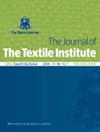不同编织设计和螺纹密度单层碳/聚丙烯编织物增强细粒混凝土组合梁的弯曲性能
IF 1.5
4区 工程技术
Q2 MATERIALS SCIENCE, TEXTILES
引用次数: 14
摘要
本研究的目的是评估螺纹密度和编织设计对单层碳/聚丙烯编织物增强细粒混凝土梁弯曲性能的影响。在这项研究中,首先,织物以两种类型的设计(平纹和斜纹)和四种不同的线密度编织。然后,它们被复合成细粒度的混凝土作为梁。4周后,采用四点弯曲试验法对所有试样的弯曲性能进行测试。使用弹性区载荷(比例极限[LOP])、峰值点(断裂模量)、韧性值和特定挠度下的韧性指标等不同参数来评估这些复合材料样品的弯曲性能。本研究还提出了新的参数:韧性值和峰值处的韧性指数。结果表明:平纹布加固混凝土梁在弹性区(LOP点)的弯曲荷载与简单混凝土梁相同,而斜纹布加固混凝土梁的弯曲荷载较低;螺纹密度的增加增加了复合材料失效点处的弯曲载荷,而编织设计的影响不显著。碳纤维/聚丙烯织物对混凝土组合梁的韧性有明显的改善,特别是在较大的弯曲挠度下,而编织设计对混凝土组合梁的韧性没有明显的影响,只对小挠度值下的韧性有影响。研究结果表明,碳纤维/聚丙烯编织物增强混凝土组合梁的平均强度是单纯混凝土梁的6.5 ~ 40.75倍。本文章由计算机程序翻译,如有差异,请以英文原文为准。
Bending properties of fine-grained concrete composite beams reinforced with single-layer carbon/polypropylene woven fabrics with different weave designs and thread densities
The aim of this study is to evaluate the effect of thread density and weave design on the bending properties of fine-grained concrete beams reinforced with single layer carbon/polypropylene woven fabric. In this study, at first, fabrics were woven with two types of design (plain and twill) and four different thread densities. Then, they were compounded into fine-grained concrete as a beam. After 4 weeks, the bending properties of all the samples were tested using four-point bending test method. The bending properties of these composite samples were evaluated using different parameters including the load at the elastic zone (limit of proportionality [LOP]) as well as the highest-peak point (modulus of rupture), toughness values, and toughness indices at the specific deflections. New parameters namely: toughness value and toughness index at the highest-peak point were also suggested in this study. The results showed that the bending load of concrete beams reinforced with plain fabric at the elastic region (LOP point) is identical to that of simple concrete beam whereas concrete beams reinforced with twill fabric exhibited lower value. Also, increasing thread density increased the bending load at the composite failure point while the effect of weave design was not significant. It is also indicated that the toughness properties of concrete composite beams have been improved with a denser carbon/polypropylene fabric particularly at higher bending deflections whereas the weave design did not show any significant effect and only influenced on toughness properties at small deflection values. The obtained results of this work suggest that concrete composite beams reinforced with carbon/polypropylene woven fabrics on average are 6.5–40.75 times tougher than simple concrete beams.
求助全文
通过发布文献求助,成功后即可免费获取论文全文。
去求助
来源期刊

Journal of the Textile Institute
工程技术-材料科学:纺织
CiteScore
4.20
自引率
5.90%
发文量
149
审稿时长
1.0 months
期刊介绍:
The Journal of The Textile Institute welcomes papers concerning research and innovation, reflecting the professional interests of the Textile Institute in science, engineering, economics, management and design related to the textile industry and the use of fibres in consumer and engineering applications. Papers may encompass anything in the range of textile activities, from fibre production through textile processes and machines, to the design, marketing and use of products. Papers may also report fundamental theoretical or experimental investigations, including materials science topics in nanotechnology and smart materials, practical or commercial industrial studies and may relate to technical, economic, aesthetic, social or historical aspects of textiles and the textile industry.
All published research articles in The Journal of The Textile Institute have undergone rigorous peer review, based on initial editor screening and anonymized refereeing by two expert referees.
 求助内容:
求助内容: 应助结果提醒方式:
应助结果提醒方式:


